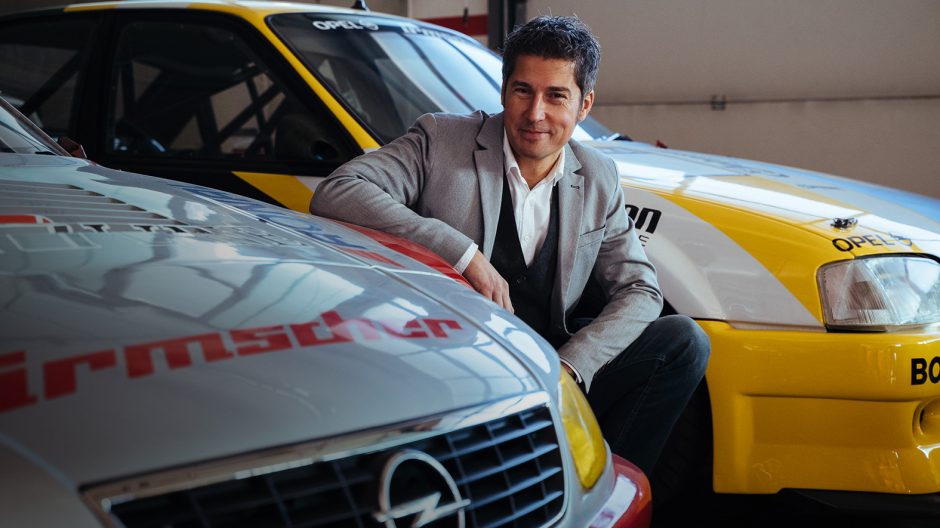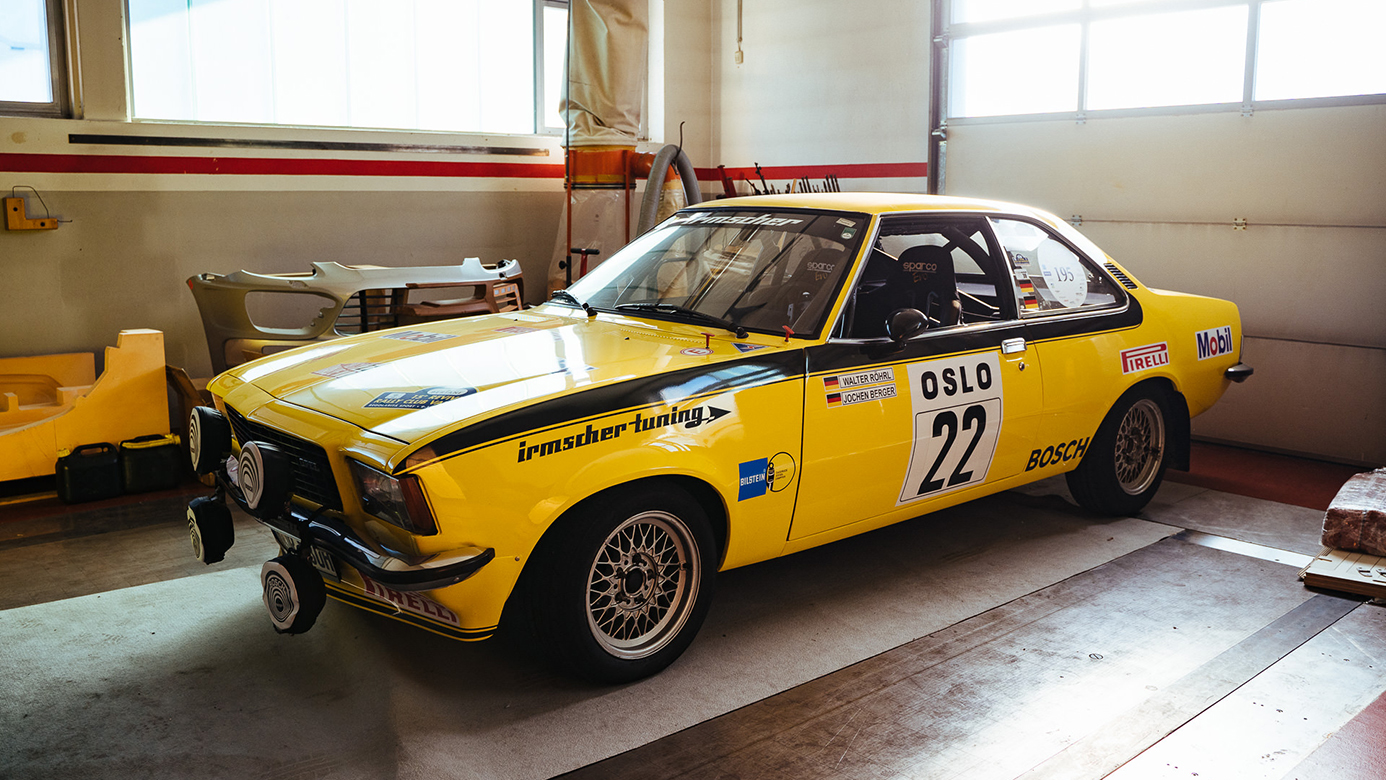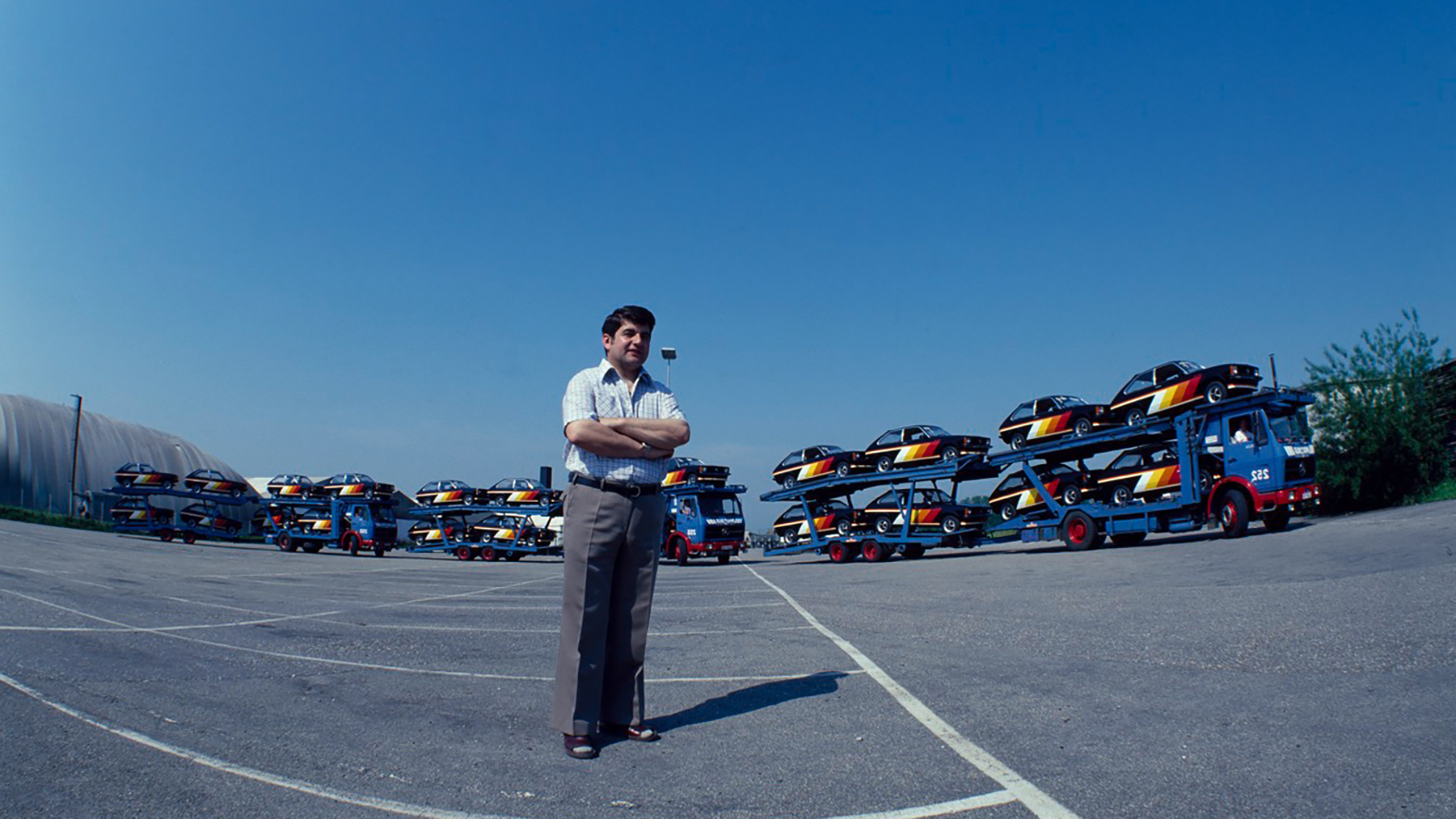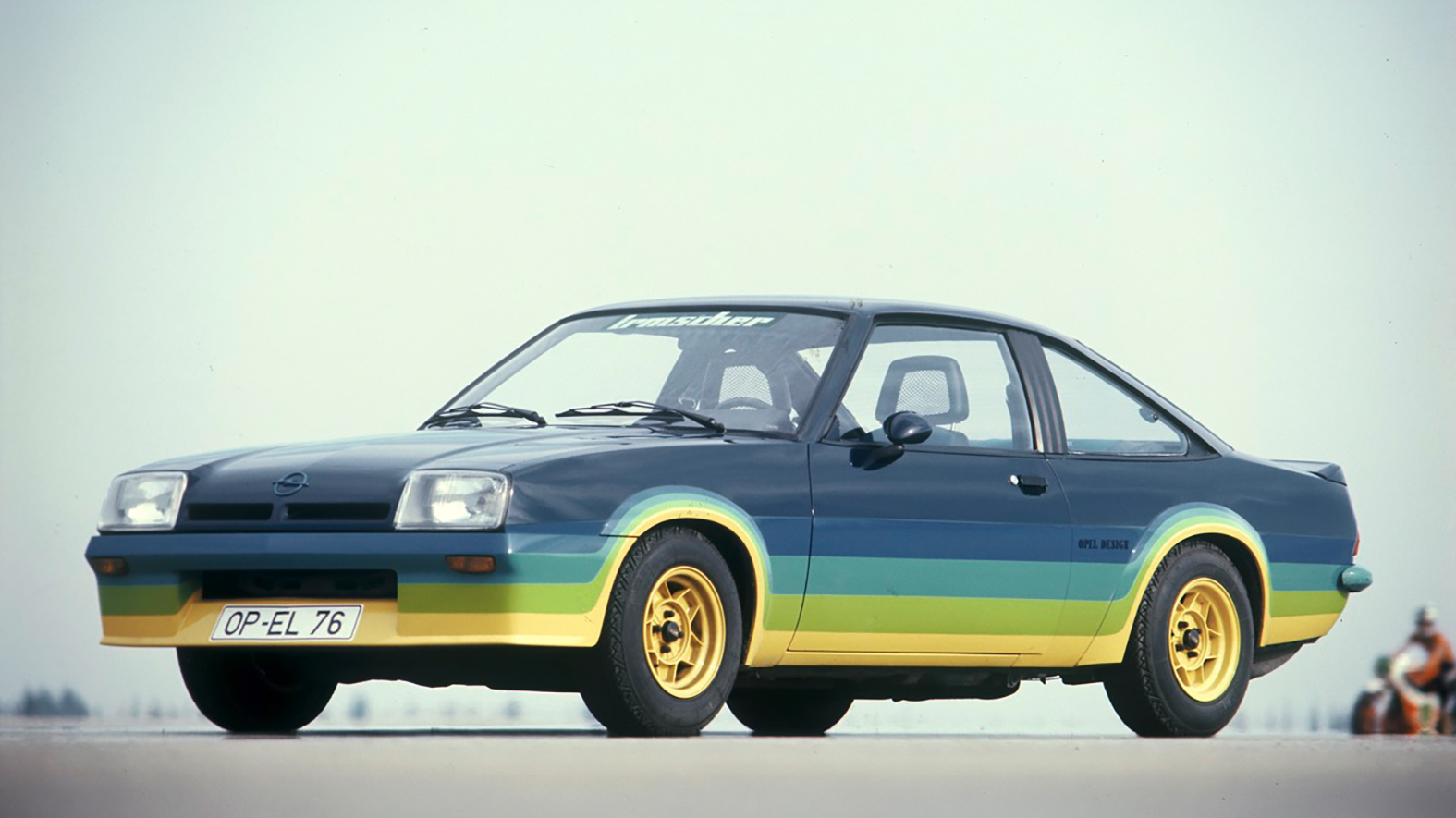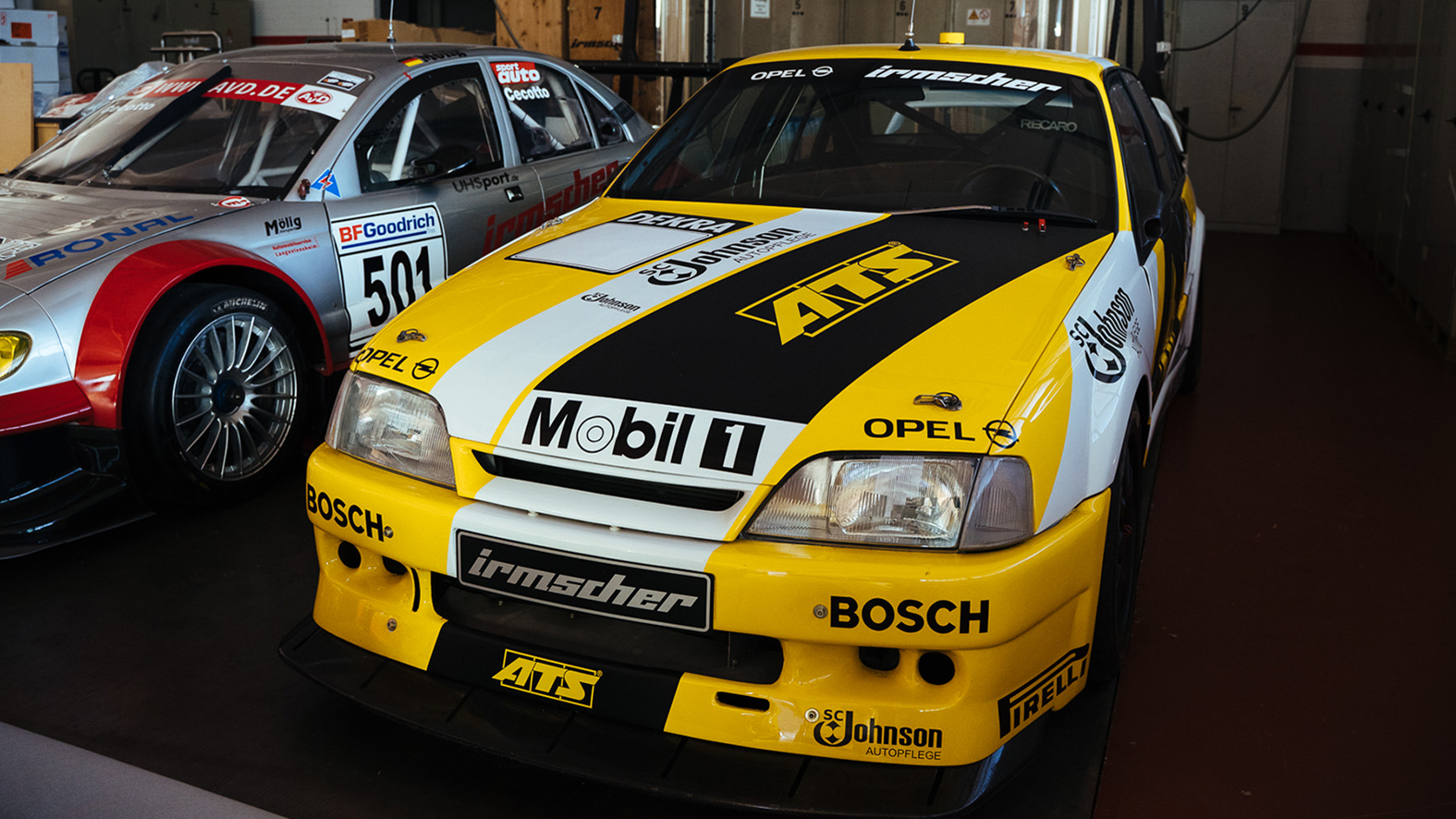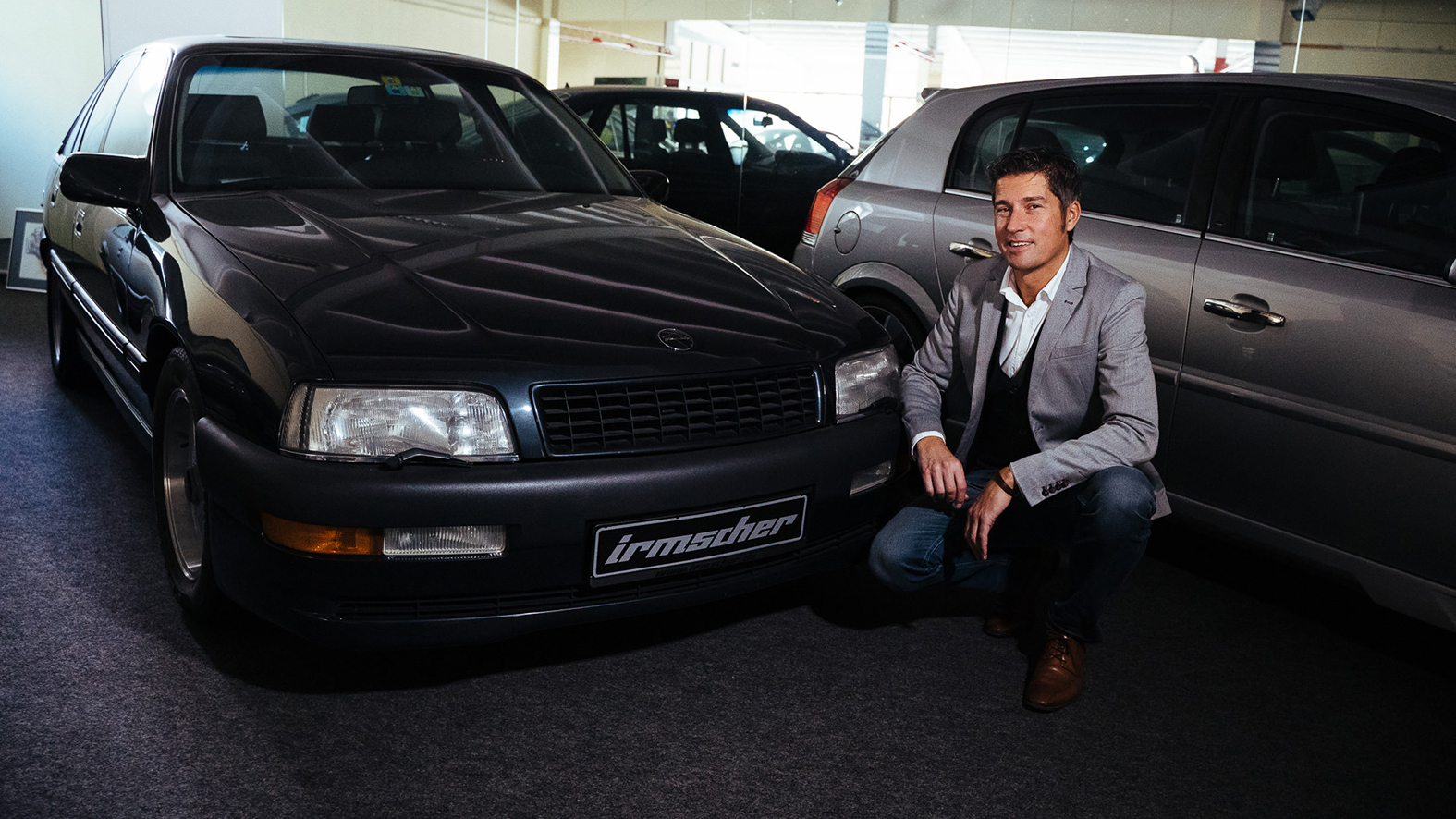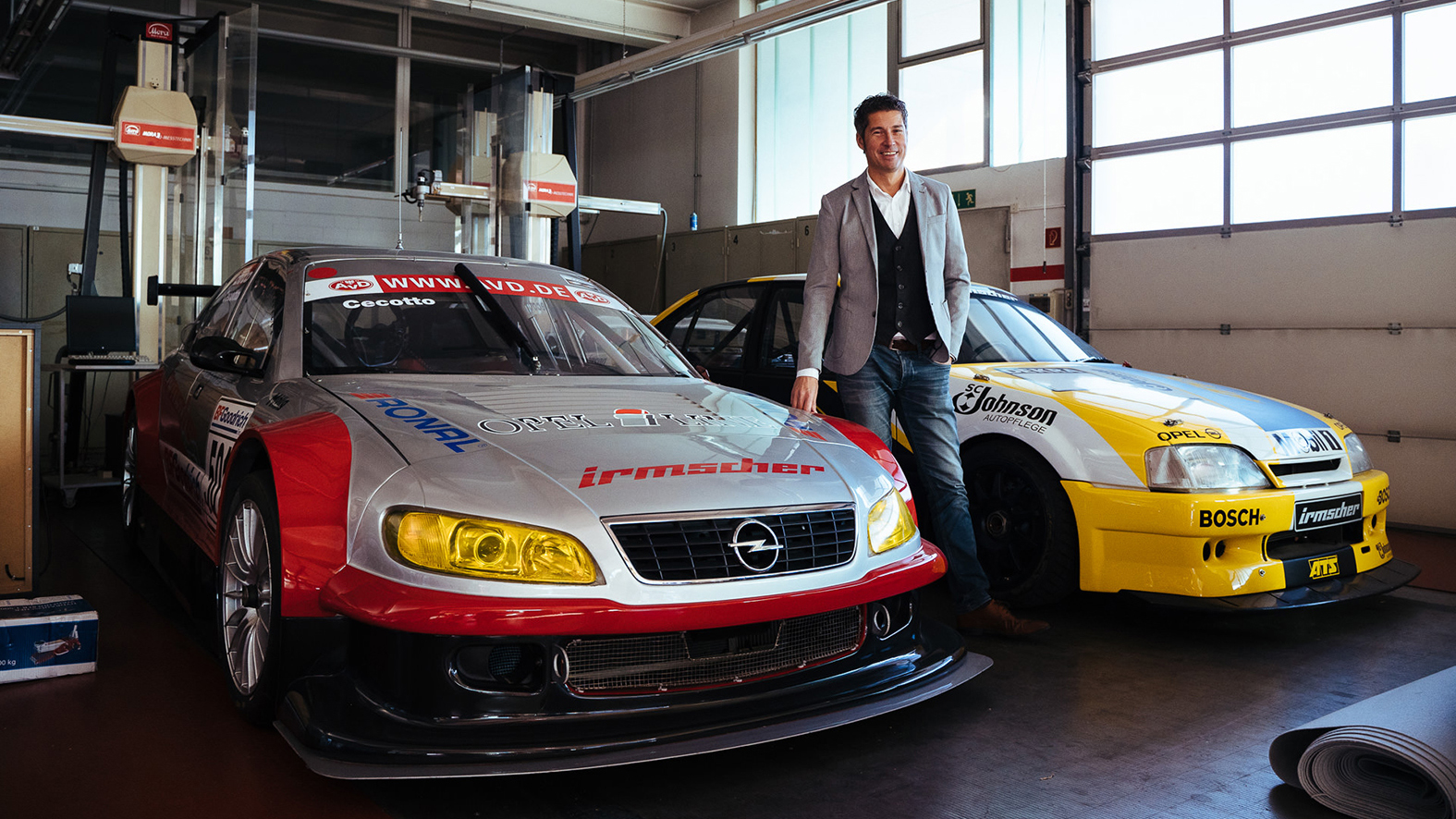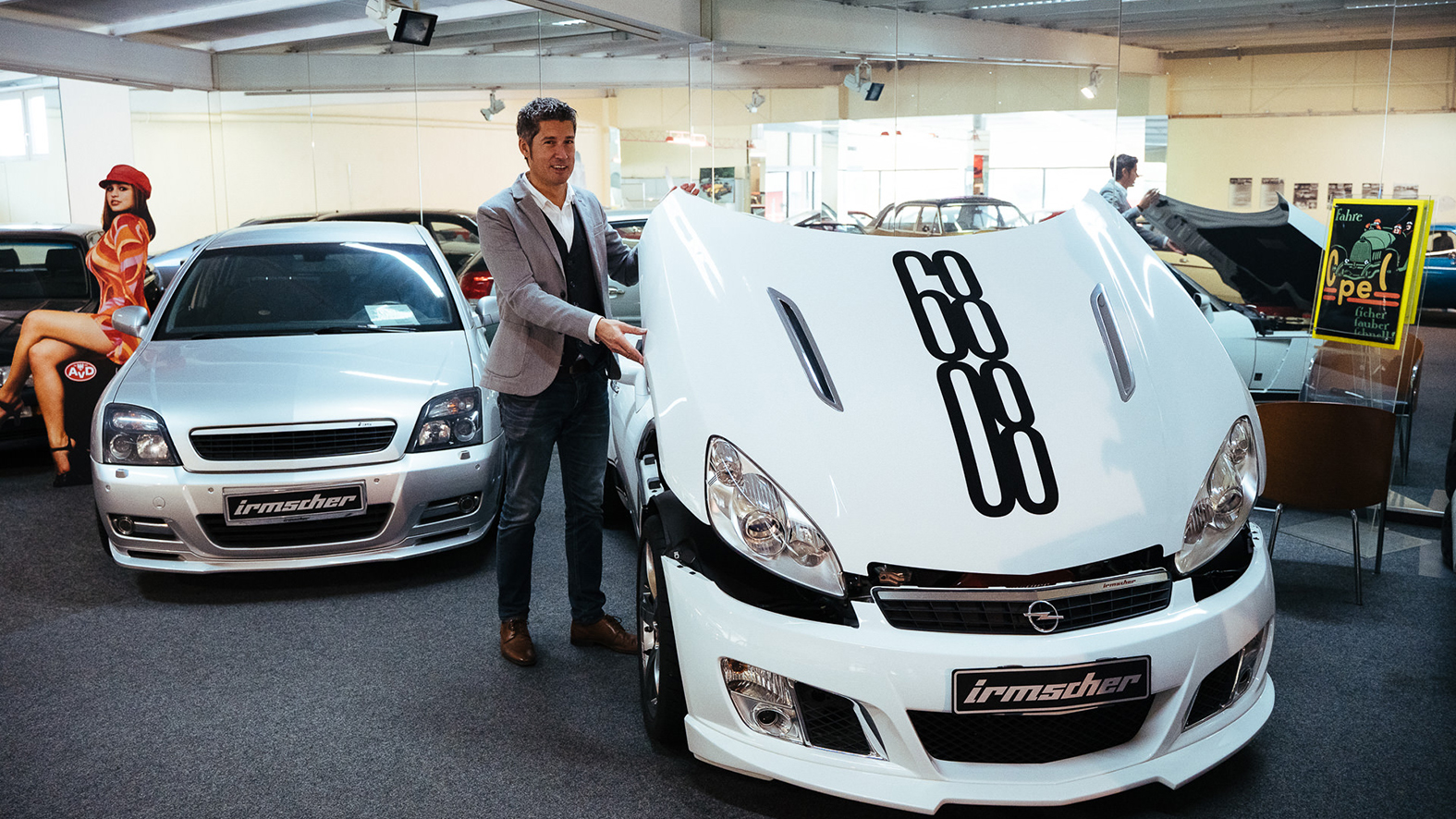- Herzlich willkommen Zum 50. Geburtstag der Irmscher Automobile zeigt Firmenchef Günther Irmscher junior die Meilensteine der Unternehmensgeschichte.
50 years of Irmscher
Günther Irmscher was a successful rally racer, whom different car manufacturers consulted for his expertise as early on as his motorsports career. That is why he felt the urge to stay true to his passion after retiring as a racer, and started his own business as a vehicle tuner. The 31-year old founded Irmscher Automobilbau at the heart of Winnenden in 1968. After just ten years, the original company headquarters became too small. Irmscher moved to the site of the old Heinkel plant in Remshalden. Today, the company is made up of 150 employees, has modification workshops in Portugal and Spain, and produces limited-edition modified and inhouse-developed series of between 50 and 2,000 models. It has long ceased to merely represent expressive sportiness. “Our signature style is individuality,” explains Günther Irmscher Jr. “This can take the form of sporty models, but also functional or cool and stylish cars” – just like the Vivaro Liner 500, produced as a special edition for the company’s 50th anniversary.
It’s a mild, sunny winter morning in Remshalden, about 20 kilometers to the northeast of Stuttgart in southwest Germany. 46-year-old Günther Irmscher, who has been the CEO of Irmscher Automobilbau GmbH & Co. KG for 19 years, sits at his desk. Memories from times gone by hang on his wall. While he may seem relaxed today, the last few months have been very eventful. His company turned 50 in 2018, which meant 12 jam-packed months of celebrations. For example, Opel’s number one partner in all things related to vehicle tuning presented a major anniversary exhibition at the Retro Classics trade fair in Stuttgart. Irmscher also celebrated its anniversary at the Essen Motor Show and specialist car dealer events. All of this had to be arranged on top of normal business operations.
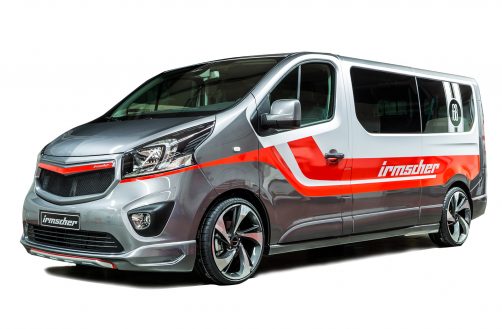
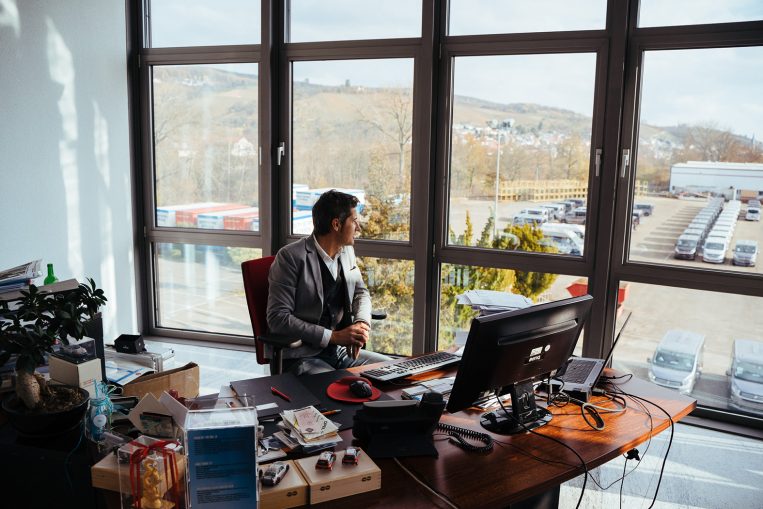
A great outlook Irmscher has an impressive view of the company premises from his desk, not to mention the foothills of the Swabian Jura mountains.
The year of the 50th anniversary also coincided with the production of the five-hundred-thousandth vehicle modified by the company. This vehicle represents a shift away from the tuning trend of ‘lower, wider, faster,’ towards a greater focus on individuality. The Vivaro Liner 68 interprets the advantages offered by the spacious Opel in terms of style and multifunctionality. 68 models were produced as a reference to the founding year of the company. However, Irmscher reports that the half-a-million figure only played a minor role in this project. “We have a long tradition of treating ourselves and our customers to a very special model with a zero at the end for every anniversary.” For example, this was the ‘i40’ in 2008 for the 40th anniversary – a GT with Irmscher DNA and an outstanding 480 HP in an incredibly light V8 engine. AutoBild magazine wrote that the model represented “Sheer delight in power.”
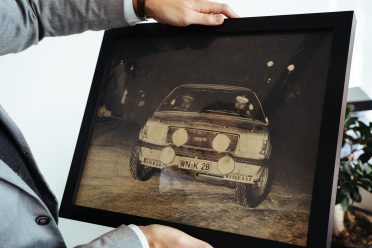
The cornerstone Jochen Berger and Walter Röhrl in the Commodore GS/E at the 1973 Monte Carlo Rally – this day marks Irmscher’s entry into rally racing.
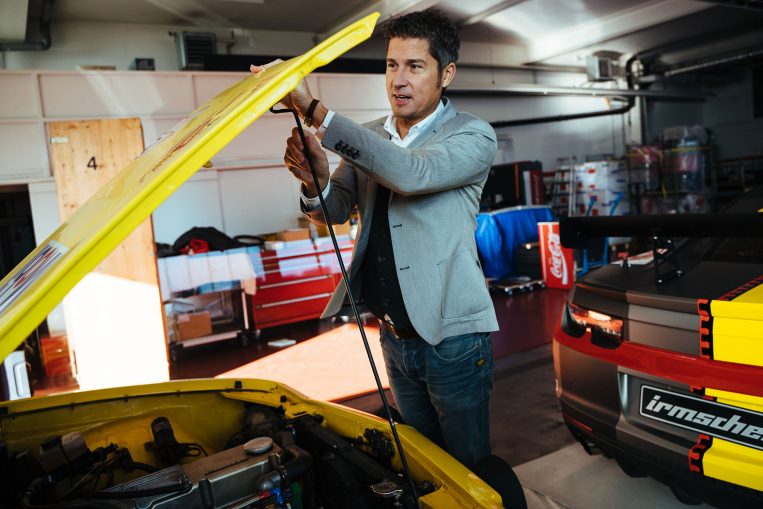
Pop the hood While Günther Irmscher never became a star racer like his father, a passion for motorsports is in his blood.
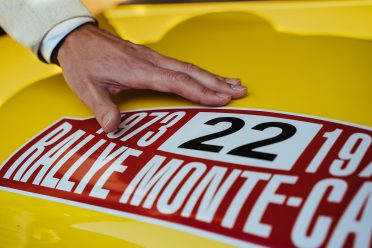
A piece of racing history The competition number 22 on the Commodore, which Walter Röhrl and Jochen Berger drove in the 1973 Monte Carlo Rally.
–––––
Modified and inhouse-developed limited-edition series
of between 50 and 2,000 units
–––––
It has always been Opel models that have set milestones in the company’s history. It all began with a Kadett – in 1968, Günther Irmscher Sr. paid for the double garage that would later become the cradle of his company with the proceeds from selling the last rally car he drove in his successful career as a racer. It was located at the heart of Winnenden, a small town with 30,000 inhabitants to the northeast of Stuttgart. Irmscher began with two employees, just as Adam Opel once did. 150 employees now make up Irmscher Automobilbau GmbH & Co. KG. The company also has modification workshops in Portugal and Spain, and produces modified and inhouse-developed limited-edition series of between 50 and 2,000 units.
An Opel Kadett also provided the impetus for the move to neighboring Remshalden in 1977. Günther Irmscher wanted to initially produce his interpretation in a limited-edition series of 500 units. He found the suitable space to do so on the premises of the former aircraft manufacturer Heinkel. A photo of the company founder, in which he poses between two powerful low-loaders filled with the expressively painted Kadett C City, now embellishes the hall of the administrative wing.
Irmscher milestones
From the Kadett C City, to the GT i40, and many more: Günther Irmscher tells us about the models that are closest to his heart. Click through the gallery:
- Commodore GS/E Coupé, 1973 „Walter Röhrl und Jochen Berger sind nach der Jungfernfahrt zwar schon bald auf einen Ascona A umgestiegen, aber seinen Platz in meinem Herzen – und in unserer Unternehmensgeschichte – kann diesem Commodore niemand mehr nehmen. Einmal, weil er fast mein Jahrgang ist. Und einmal, weil er unseren Einstieg in den Rallyesport markiert. Röhrl und Berger traten damit 1973 bei der Rallye Monte Carlo an. Mit einem so großen Auto in diesen engen Gassen zu starten, war eine Sensation.“
- Kadett C City, 1977 „Es war dieser Kadett, der unseren Umzug aus der Innenstadt von Winnenden nach Remshalden notwendig machte. Wir wollten 500 Exemplare davon produzieren. Und es war das erste Mal, dass wir eine solche Stückzahl in Angriff nahmen. Dazu brauchten wir Platz. Zum Teil wurden die Autos damals auch nachts angeliefert und mein Vater, der auf diesem Bild zu sehen ist, fuhr sie vom Lkw herunter – mit mir als Beifahrer. Ich war damals gerade fünf Jahre alt, doch mir kommt es vor, als wäre es gerade gestern gewesen. Dieser Kadett C City machte ganz schön was her, allein schon dank seiner expressiven Lackierung.“
- Irmscher i2800, 1978 „Ein Sechszylinder-Motor mit 2,8 Liter Hubraum, der passte gut unter die Motorhaube eines Commodore – aber unter die eines Manta B? Mein Vater hat es mit seinem Team irgendwie fertiggebracht, ihn dort einzusetzen. Dementsprechend ging in diesem Sportcoupé anschließend die Post ab. Auch insgesamt machte das Modell eine eigenständige Entwicklung notwendig, sodass wir uns entschlossen, es weder als Opel noch als Manta zu bezeichnen, sondern zum 13. Automobilhersteller Deutschlands zu werden. Der „i2800“, den wir ebenfalls in Kleinserie produzierten, war unser erstes Auto mit einem eigenen „Irmscher“-Logo auf dem Kühlergrill. Ein Geschenk, das wir uns selbst zum zehnjährigen Bestehen unseres Unternehmens machten.“
- Omega Evo 500, 1991 „Mit diesem sogenannten ‚Evolutionsmodell‘ starteten Volker Strycek, heute Leiter des Opel Performance Centers, und Franz Engstler 1991 in der DTM. Ich weiß noch, wie ich eines der ersten Rennen nach dem Mauerfall auf der Berliner AVUS besuchte. Ich hatte gerade den Führerschein gemacht, mir als erstes Auto einen Kadett C zugelegt. Zu diesem Rennen aber kam ich selbst in einem Omega. Dieses Modell haben wir jetzt im Jubiläumsjahr noch mal neu aufbauen lassen – ganz bewusst von den gleichen Mitarbeitern, die auch damals schon dafür verantwortlich zeichneten.“
- Irmscher Senator B 4.0i, 1993 „Dieser Senator war der letzte Dienstwagen meines Vaters. Von 1993 bis zu seinem Tod 1996 ist er damit rund 300.000 Kilometer gefahren. Als wir das Modell 1992 auf den Markt brachten, galt sein 272 PS-Motor als der drehmomenstärkste der Welt. Abgesehen davon, dass es heute nicht mehr viele davon gibt – dieses Exemplar würde ich niemals hergeben.“
- Omega B mit V8-Motor, 1999 „Diesen Omega fuhr ab 2001 der ehemalige Formel 1-Pilot und Motorrad-Weltmeister Johnny Cecotto in der damals neu gegründeten V8 Star-Serie. Wie man sieht, hatte sich die Farbgebung für unsere Rallyemodelle mittlerweile geändert. Gelbe Lackierung und grüne Motoren waren jahrelang unser Markenzeichen, nun präsentierten wir uns in stylischem Grau-Rot. Der Zeitgeist ändert eben auch die Geschmäcker, heute ließe sich unser damaliges Grün und Gelb wieder als ‚Retro‘-Design vermarkten … Ich persönlich verbinde mit diesem Omega meinen endgültigen Einstieg ins Unternehmen. Nach meinem Studium konnte ich ab 1999 das Lebenswerk meines Vaters auch ‚Vollzeit‘ fortsetzen.“
- Irmscher GT i40, 2008 „Zu jedem zehnten Geburtstag gönnt Irmscher sich und seinen Kunden etwas ganz Besonders. Dieses Modell präsentierten wir zu unserem 40. Geburtstag: einen GT mit Irmscher-Genen, ebenfalls eine eigenständige Neuinterpretation, daher trägt er das Irmscher-Logo. Ein offener Zweisitzer mit einem 480 PS starken, dennoch erstaunlich leichten V8-Aggregat. Die ‚Autobild‘ sprach von ‚purer Lust an der Power‘.“
–––––
I test drive each and every one of our models
–––––
An Opel also paved the way for Günther Jr.’s entry into his father’s company. His first car was a Kadett C back in 1989, the year the Berlin Wall fell. While Günther Irmscher never became a star racer like his father, he has always maintained an avid interest in the company’s involvement in motorsports: “Which of course also means that I test drive each and every one of our models.”
In 1991 Volker Strycek, now head of the Opel Performance Center, and Franz Engstler started the German Touring Car Championship on the AVUS track in Berlin in a racer version of the Opel Omega Evo 500. The 20-year-old Günther Irmscher Jr. also drove this model for the occasion. One of these models can now be found in a garage in the workshop area. “We had the rally version reconstructed in 2018 by the same employees who were responsible for making the original.” What a way to celebrate an anniversary!

↑ Between Legends Irmscher with the versions of the Omega Evo 500 (right) and Omega B with a V8 engine.
→ A unique rim Irmscher unites car manufacturing with manual work. Models like these are made from paper and wood. The rim is an Irmscher ‘heli-star’ which imitates the design of a helicopter rotor. It looks particularly good on Opel X models.
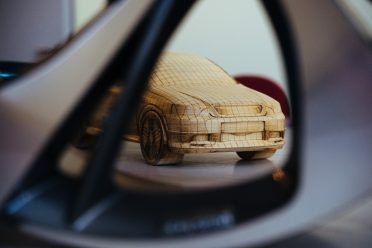
–––––
Günther Irmscher Sr.’s memory lives on throughout the company
–––––
Günther Irmscher Jr. officially took on his father’s life’s work after he completed his degree in 1999. Günther Sr., who had founded the company aged 31, died in 1996 at just 59 years of age. His memory lives on throughout the company. Not only is his rally helmet from his motorsports career exhibited in the show room, but so is his last company car, an Irmscher Senator B 4.0i from 1993.
“My father drove about 300,000 kilometers in it between 1993 and 1996,” says Irmscher. “When we launched the model in 1992, his 272 HP engine had the highest torque in the world.” Hardly any exist today, which means that they could rack up a high collector’s price nowadays. The operative word being ‘could,’ “as we would never trade this car for anything in the world.”
February 2019
